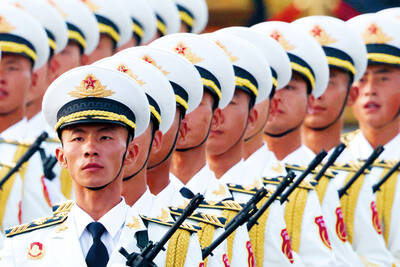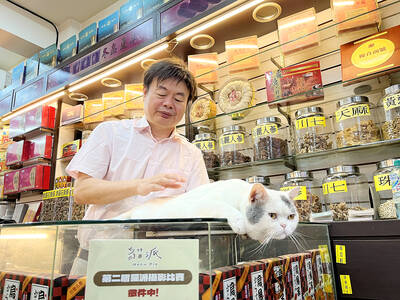Increased interest among collectors in China and elsewhere has inflated the value of historic coins, with the Qing Dynasty “Silver Dragon” coin fetching more than triple what it did five years ago, a collector said.
Old silver and copper coins have been readily available on the market over the past few decades, as many have been stowed away as keepsakes by those who lived through Taiwan’s many transfers of power, the collector, surnamed Liu (劉), said on Jan. 25.
“Finding a rare Silver Dragon in your house amounts to directly depositing hundreds of thousands of [New Taiwan] dollars into your account,” Liu said.

Photo: Wang Kuan-jen, Taipei Times
The “Fatman” coin that features the profile of Yuan Shikai (袁世凱), the first official president of the Republic of China, is no different.
A public official surnamed Huang (黃) and a classmate a few decades ago scrounged together more than NT$100,000 to buy 10 of the coins, which were issued from 1914 to at least 1921.
Huang, not knowing he should have them appraised, has kept them in a moisture-proof box at home.
When a call came from his classmate offering to buy them for more than double what they had originally paid, he was shocked.
Qing Dynasty and Japanese colonial-era coins are made of at least 90 percent pure silver, giving them an inherent value, Taipei Numismatics Society chairman Sam Wang (王皇文) said.
The silver in each coin is worth NT$600 to NT$700, but with the imprinted design, the coin’s value increases to at least NT$800, Wang said.
More than 10 years ago, most coins only cost about NT$800 to NT$1,200, making them a stable investment, he said.
However, Chinese interest has skyrocketed over the past decade for Qing and early Republican-era coins from Taiwan, Japan and other countries, driving up the price, Wang said, adding that under Chinese law, historic Chinese coins cannot be sold outside the country.
As another example, a silver coin issued from 1898 to 1907 during the reign of the Guangxu Emperor (光緒) could be bought for NT$2,000 or NT$3,000 more than 10 years ago, Wang said.
Now, a prospective buyer would be hard-pressed to find one for less than NT$10,000, he added.
Compared with the dramatic price increase for the Guangxu and Yuan Shikai coins, silver coins issued by Japan have remained relatively stable, increasing by only about NT$1,000, Wang said.
More than a decade ago, the coins went for NT$1,000 or NT$2,000, but they now fetch about NT$2,000 to NT$3,000, he said.
The run is not limited to silver coins — Qing Dynasty-era copper coins have also experienced a substantial boost in value.
After seeing them in a book more than 10 years ago, a teenager from Keelung surnamed Wu (吳) rushed to Guling Street (牯嶺街) in Taipei’s Zhongzheng District (中正), which is famous among stamp and coin collectors, to buy coins from the reigns of five influential Qing emperors.
Each coin that Wu bought for only a few dozen New Taiwan dollars at the time is now worth about NT$1,000.
Despite their relative abundance, the coins are highly valued for their auspicious and protective connotations, attracting outsized interest from culturally Chinese buyers.
This is especially true for the relatively rare tongbao (通寶) copper coin issued during the reign of the Yongzheng Emperor (雍正) from 1723 to 1735, one of which costs as least NT$500.
When sold as a set, copper coins from the reigns of the Shunzhi (順治), Kangxi (康熙), Yongzheng (雍正), Qianlong (乾隆) and Jiaqing (嘉慶) emperors have grown in value from NT$1,000 or NT$2,000 to at least NT$3,000 over the past decade.
Amid the bull market for historic coins, fakes have been flowing into the market, Wang said.
The forgeries have become more sophisticated in the past few years, often fooling those without the tools or experience to discern genuine coins from fake ones, he added.
Wang suggested that interested buyers or sellers go through a trustworthy coin collecting organization, which can verify the coins’ authenticity and provide a more robust price guarantee.
Collectors can also pay a small fee to have their collection authenticated by international graders, such as the Professional Coin Grading Service or Numismatic Guaranty Corp, he added.
Wang had a word of advice on cleaning coins.
It used to be common practice among Taiwanese collectors to buff coins “until they shine,” Wang said.
However, many modern enthusiasts from China believe that coins that are “too clean” might be fake or lack a “historic feel,” he said.
Nowadays, there are ardent adherents to both camps, Wang said, so collectors should make a decision with this in mind.

The Chinese military has built landing bridge ships designed to expand its amphibious options for a potential assault on Taiwan, but their combat effectiveness is limited due to their high vulnerability, a defense expert said in an analysis published on Monday. Shen Ming-shih (沈明室), a research fellow at the Institute for National Defense and Security Research, said that the deployment of such vessels as part of the Chinese People’s Liberation Army (PLA) Navy’s East Sea Fleet signals a strong focus on Taiwan. However, the ships are highly vulnerable to precision strikes, which means they could be destroyed before they achieve their intended

The first two F-16V Bock 70 jets purchased from the US are expected to arrive in Taiwan around Double Ten National Day, which is on Oct. 10, a military source said yesterday. Of the 66 F-16V Block 70 jets purchased from the US, the first completed production in March, the source said, adding that since then three jets have been produced per month. Although there were reports of engine defects, the issue has been resolved, they said. After the jets arrive in Taiwan, they must first pass testing by the air force before they would officially become Taiwan’s property, they said. The air force

GLOBAL: Although Matsu has limited capacity for large numbers of domestic tourists, it would be a great high-end destination for international travelers, an official said Lienchiang County’s (Matsu) unique landscape and Cold War history give it great potential to be marketed as a destination for international travelers, Tourism Administration Director General Chen Yu-hsiu (陳玉秀) said at the weekend. Tourism officials traveled to the outlying island for the Matsu Biennial, an art festival that started on Friday to celebrate Matsu’s culture, history and landscape. Travelers to Matsu, which lies about 190km northwest of Taipei, must fly or take the state-run New Taima passenger ship. However, flights are often canceled during fog season from April to June. Chen spoke about her vision to promote Matsu as a tourist attraction in

PAWSITIVE IMPACT: A shop owner said that while he adopted cats to take care of rodents, they have also attracted younger visitors who also buy his dried goods In Taipei’s Dadaocheng (大稻埕), cats lounging in shops along Dihua Street do more than nap amid the scent of dried seafood. Many have become beloved fixtures who double as photography models, attracting visitors and helping boost sales in one of the capital’s most historic quarters. A recent photo contest featuring more than a dozen shop cats drew more than 2,200 submissions, turning everyday cat-spotting into a friendly competition that attracted amateur and professional photographers. “It’s rare to see cats standing, so when it suddenly did, it felt like a lucky cat,” said Sabrina Hsu (徐淳蔚), who won the NT$10,000 top prize in